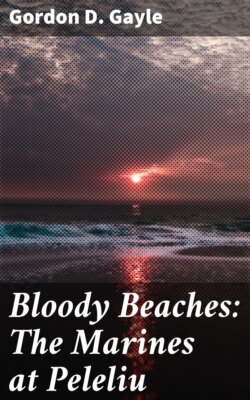Читать книгу Bloody Beaches: The Marines at Peleliu - Gordon D. Gayle - Страница 7
На сайте Литреса книга снята с продажи.
Оглавление[Sidebar (page 7):]
Naval Gunfire Support for Peleliu
Table of Contents
Department of Defense Photo (USMC) 95115
In their earlier operations, especially at Guadalcanal, the primary experience of 1st Division Marines with naval gunfire was at the receiving end. On New Britain, the character and disposition of Japanese defenses did not call for extensive pre-landing fire support, nor did subsequent operations ashore. The naval gunfire to which the Guadalcanal veterans were exposed frequently and heavily damaged planes and installations ashore. Its effect upon dug-in Marines was frightening and sobering, but rarely destructive.
During the planning for Peleliu, the division staff initially had no trained naval gunfire (NGF) planner. When one arrived, he was hampered by the cumbersome communications link back to higher headquarters, Lieutenant General Holland M. Smith’s Fleet Marine Force, Pacific (FMFPac), in Honolulu, which would provide the essential targeting information for the division’s NGF plan. FMFPac also would plan and allocate the available gunfire resources to the targets deemed important by the division staff’s planners. The preoccupation of FMFPac with the ongoing Marianas campaigns, as well as illness on the staff of Rear Admiral Jesse B. Oldendorf, Commander, Naval Gunfire Support Group, further limited and constrained the preparations. Heavy ammunition expenditures in the Marianas reduced ammunition availability for Peleliu.
Surprisingly, during the delivery of U.S. preparatory fires, there was no Japanese response. This prompted Oldendorf to report all known targets destroyed, and to cancel preparatory fires scheduled for D plus 3. An unintentional benefit of this uncoordinated change in naval gunfire plan may have resulted in there being more shells available for post-landing NGF support. But the costliest effect of inadequate NGF was that the flanking positions north and south of the landing beaches were not taken out. The selection of naval gunfire targets could certainly have been done with more careful attention. Colonel Lewis B. Puller, the 1st Marines commander, had specifically asked for the destruction of the positions dominating his landing on the division left flanks. Failure to do so was paid for in blood, courage, and time during the critical battle for the Point.
Subsequent to D-Day there were numerous instances of well-called and -delivered naval gunfire support: night illumination during the night of 15–16 September, the destruction of two major blockhouses earlier reported “destroyed,” and effective support of the Ngesebus landing toward the end of the battle.
